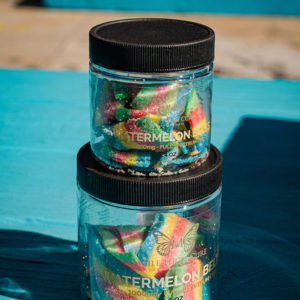THC, Marijuana and Cannabis Edibles: A Miami Doctor Explains The Difference
Dr. Fernando Fandiño-Sende of LifeCannMD in Miami, Florida has successfully assisted over 3,000 patients with obtaining their medical marijuana card. His understanding of the various uses and components of the plant is unrivaled. Here he explains the difference between THC, Marijuana and Cannabis edibles.
Cannabis, One Medicine for One Hundred Conditions.
– Dr. Fernando Fandiño-Sende
 A cannabis plant has over 100 components – with over 400 chemical entities of which over 60 of them are cannabinoid compounds. The primary active cannabinoids in the plant are phytocannabinoids. The other cannabinoids are endocannabinoids which actually already exist in the human body. This endocannabinoid system is a modulatory system in the function of the brain, endocrine, and immune tissues. Additionally, it controls energy homeostasis and influences the function of the food intake centers in the central nervous system and gastrointestinal tract. There is always confusion surrounding the components of the plant with regard to actual marijuana, Edibles, and the compound THC.
A cannabis plant has over 100 components – with over 400 chemical entities of which over 60 of them are cannabinoid compounds. The primary active cannabinoids in the plant are phytocannabinoids. The other cannabinoids are endocannabinoids which actually already exist in the human body. This endocannabinoid system is a modulatory system in the function of the brain, endocrine, and immune tissues. Additionally, it controls energy homeostasis and influences the function of the food intake centers in the central nervous system and gastrointestinal tract. There is always confusion surrounding the components of the plant with regard to actual marijuana, Edibles, and the compound THC.
THC
In 1964, Gaoni and Mechoulam isolated the main active compound, delta-9-tetrahydrocannabinol – d-9-THC. THC is the main phytocannabinoid compound that produces the high. In short, THC is defined by what feelings a cannabis product can produce versus CBD products – which, more often than not, can’t be felt. THC causes the release of dopamine in the brain – this produces euphoria and a generally pleasant sensation.
THC is commonly used for pain relief, anxiety control, appetite stimulation for the ill or in treating Anorexia and Cachexia, insomnia, nausea and vomiting, Spasticity, movement disorders, Glaucoma, Epilepsy, Asthma, Autoimmune diseases, Inflammation And a variety of psychiatric symptoms.
Reaction to THC varies from person to person and therefore the amounts vary as well. One patient may feel nothing while another could have the same amount and experience a strong psychoactive response. It’s best to explore with a certified doctor whether smoking or ingesting is the optimum path forward for each individual.
Marijuana
In the U.S., the level of THC is the legal defining line of marijuana. Plants which contain 0.3% THC or less. are known as hemp whereas plants exceeding 0.3% are considered marijuana and are therefore regulated federally under the U.S. Controlled Substances Act (CSA). Known as Species Cannabis Sativa L, most medical marijuana is a hybrid of Sativa and Indica. Indica strains usually have higher concentrations of CBD – a non-psychoactive component of cannabis. Sativa strains, however, typically have more THC content. Only a doctor can help determine which strain or plant variety is best for a patient’s individual needs.
Smoking offers a fast and effective way to relieve debilitating symptoms. Marijuana may be smoked rolled up like a cigarette, in a pipe, or in a vaporizer. The effects of smoking marijuana are felt as soon as the THC enters the bloodstream and can last from 1-3 hours. Smoking marijuana causes chemical changes in the brain that can result in neuro-protective effects as well as changes in psychomotor abilities, cognitive processes, as well as psychoactive effects.
Edibles
Marijuana may also be consumed as a tea or in food. The edible industry is a popular alternative to those not wanting to introduce smoke into their lungs and typically, less THC is consumed from edibles than from smoking – however, it can stay inside the body much longer. In 2014, 1.96 million units of edible medicinal cannabis-infused products and 2.85 million units of edible retail cannabis-infused products were sold in Colorado accounting for almost 45 percent of total cannabis sales in the state.
Initial absorption of THC is slower if ingested – typically producing effects 30 minutes to an hour after ingestion and lasting 7 to 12 hours. With edibles, the THC goes into the stomach before being rerouted into the liver. Though THC is oil-soluble, the digestive process makes it water-soluble. As a result of this, a much larger fraction of Delta-9-THC makes it to the liver where it gets converted to 11-hydroxy-THC. A 1973 study concluded 11-hydroxy-THC was a more intense and long-lasting high.
10mg of THC is the single serving size of marijuana-infused products. Newer patients should start with 5mg or 2.5mg. It pays to be patient and may take a few tries to get the right dosing. Doctors with a medical marijuana practice understand precise dosing and the different cannabis strains chosen to ease a particular condition.
LifecannMD is Florida’s top-rated medical marijuana referral clinic. With board-certified doctor, Dr. Fernando Fandiño-Sende and staff, the right ingestion of a cannabis based product is their primary goal for each individual patient seeking relief with medical marijuana.






